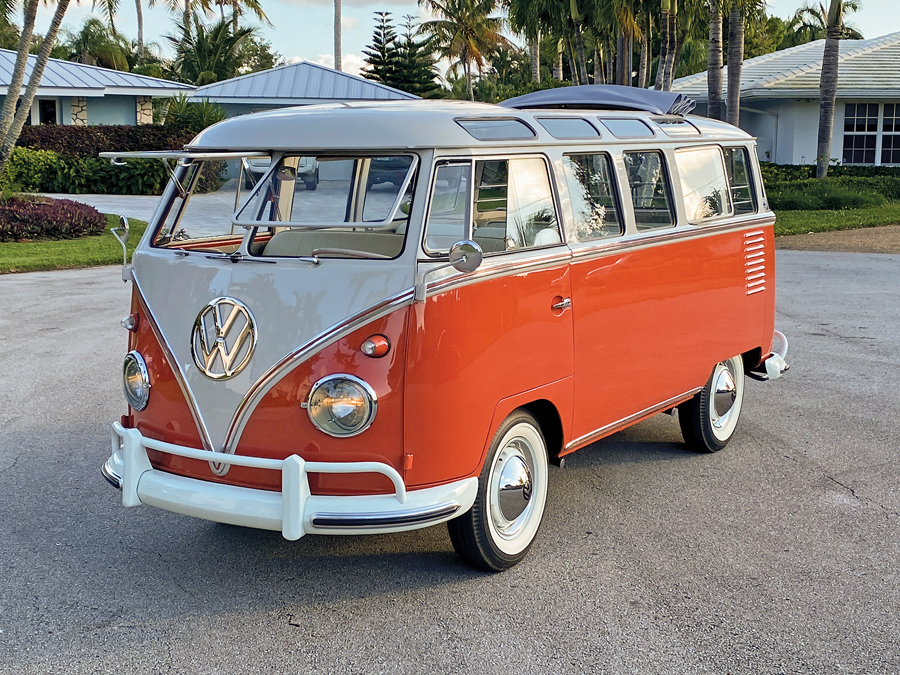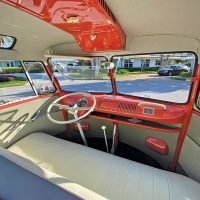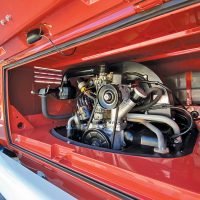SCM Analysis
Detailing
| Vehicle: | 1961 Volkswagen Deluxe 23-Window Microbus |
| Years Produced: | 1951–63 (21-window to 1967) |
| Number Produced: | 101,829 |
| Original List Price: | $2,495 (1961) |
| SCM Valuation: | $119,500 |
| Tune Up Cost: | $50 |
| Distributor Caps: | $10 |
| Chassis Number Location: | Behind front passenger’s seat |
| Engine Number Location: | Stamped on a boss below the generator support |
| Club Info: | Vintage Volkswagen Club of America |
| Website: | http://www.vvwca.com |
| Alternatives: | 1961–65 Chevrolet Greenbrier, 1961–67 Ford Econoline, 1964–70 Dodge A100 |
| Investment Grade: | B |
This car, Lot 249, sold for $159,500, including buyer’s premium, at RM Sotheby’s Palm Beach, FL, online auction on March 28, 2020.
A friend recently posed this rhetorical question: “Has anyone ever bought a car from eBay and found it was better than they expected when it arrived?” He suspected that had never happened, and for the most part, he’s probably right.
Yet with the social limitations currently in place in response to COVID-19, collectors are being forced to buy sight-unseen cars if they want to buy at all.
Taking the show online
Faced with travel and public-gathering restrictions, RM Sotheby’s might have canceled their 18th Annual Palm Beach Auction, but with more than a week until the gavel was set to fall, the company moved the entire show to its online platform.
“We had many clients who were counting on us to sell their cars in this market and significant bidder interest gearing up for the physical auction,” said RM Sotheby’s president Kenneth Ahn.
That move could have unnerved sellers fearful of reduced bids or unqualified bidders, but RM Sotheby’s seems to have made a refreshing jug of Florida lemonade out of a distinctly sour state of the world. The company reported nearly 900 bidders from 44 countries participating, besting the in-person average for this auction by 23%. Furthermore, 36% of those bidders were first-timers at RM Sotheby’s.
Remote, online and proxy bidding has been around in some form for decades. Eliminating the in-person aspect surely takes some excitement and pressure off the transactions, but it doesn’t seem to have deflated the results. At least not by much.
A clean Samba
Among the cars sold at this auction was this 1961 Volkswagen Deluxe Microbus, commonly known as a 23-Window Samba. These have been the queens of VW production, pulling top money at auctions over the past several years. With plenty of comparable sales, this van is a perfect yardstick for the success of this auction.
The 23-Window Samba was produced from 1951 to 1963, changing to a 21-Window configuration for 1964–67. The primary difference is two curved windows at the rear corners of the vehicle that disappeared after 1963. Both the 23- and 21-Window varieties are about equally desirable, and the SCM Pocket Price Guide lists a median price of $119,500 for a good one.
The van in question appears impeccably clean in the auction photographs. The engine serial number checks out as a 40-horsepower, 1,200-cc engine manufactured in 1961 and still bearing all its original equipment. A few pimples on older chromed parts, some dings on the trim spears, and some separation in the window glass are the only flaws visible. This is a Samba that any collector would be proud to own.
It also helps that the bus comes with provenance all the way back to the original dealership purchase. Together with the excellent set of detailed photographs, this Samba was set to succeed in an online auction.
Vote with your dollars
The bidders must have agreed that this VW was special, as it pulled good money. It didn’t reach the exuberant $302,500 that a bidder paid for a 1965 21-Window model back in 2017 (SCM# 6826646), but the sale price was respectable money befitting the quality of the vehicle — and well on the sunny side of the median.
It’s possible that the van could have brought more in a live auction where bidders had the chance to experience the Samba in its glory and fall in love before bidding. But the online format also seems to have brought in new bidders, so it’s impossible to say for sure.
The sharp recession could also have stopped this VW from reaching its highest potential price, but it certainly didn’t result in a disappointing sale.
The shape of auctions to come?
Here’s a personal opinion: Anyone who tries to predict what’s going to happen in the next six to 12 months is either a charlatan or a fool. I’ll cop to the latter right away and save you the trouble of pointing it out.
It may play out that 2020 is the year that auctions go virtual. If buyers still come and bid at respectable amounts, that’s big savings for auction houses who no longer have to arrange or erect venues. I’m not foolish enough to think they’ll pass the savings back to the buyers and sellers, though. However, I don’t think we’ll see the end of live auctions once the viral danger has passed. The energy and community of a live auction is too tasty a brew to give up forever.
Yet we may see online bidding grow as buyers become more comfortable making a purchase in absentia. What that means is that sellers and auction houses will have all the more incentive to take and publish detailed photos and offer as much solid information as possible about each vehicle, and that’s a win for everyone involved. ♦



